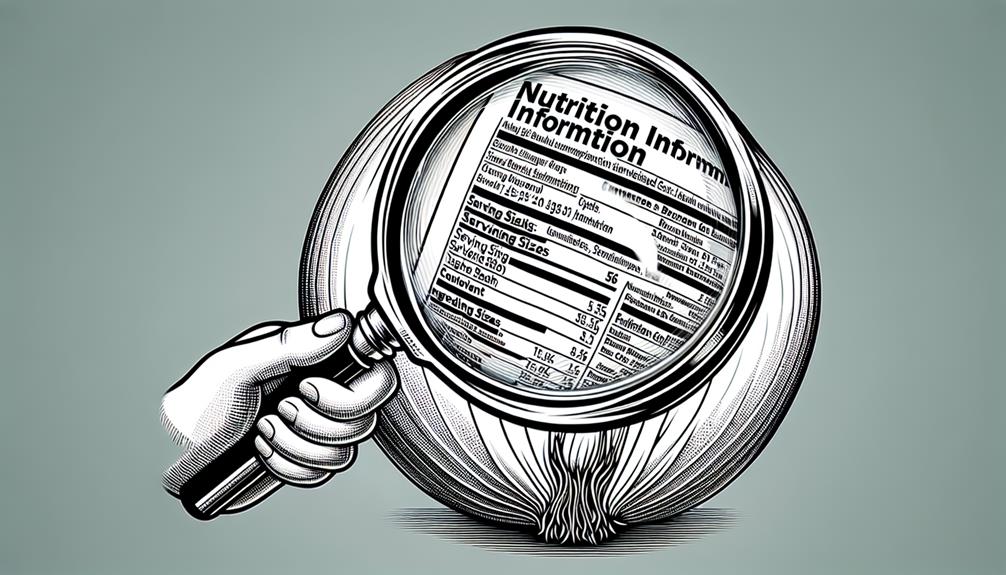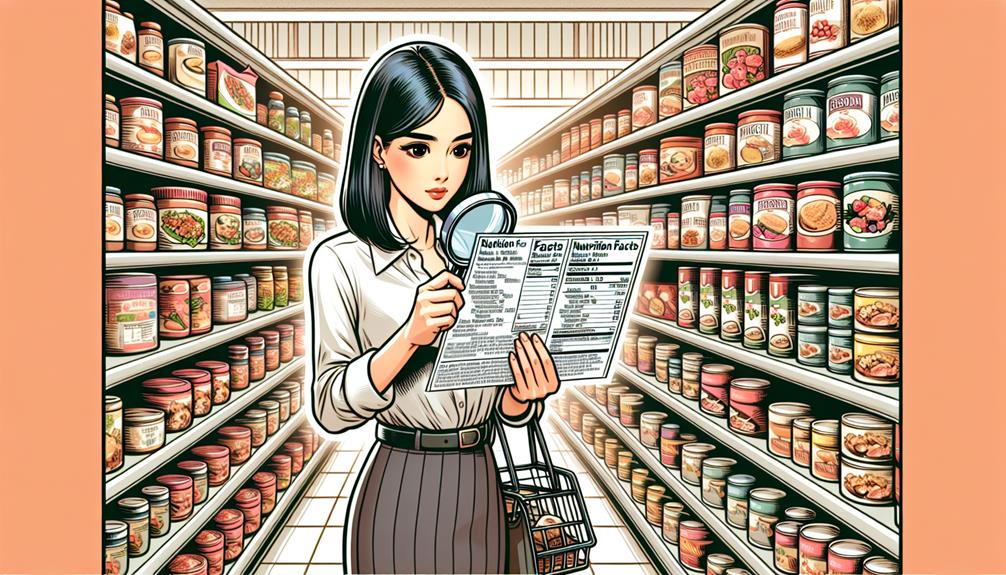Step into the labyrinth of the grocery store, where the shelves are lined with rows upon rows of colorful packages, each vying for your attention. As you reach out to grab that enticing box of cereal or that tempting bag of chips, have you ever wondered what lies beneath the labels? Behind the glossy packaging and flashy claims, there is a hidden world of information waiting to be deciphered. In this article, we will unravel the mysteries of food packaging and nutrition facts, shedding light on the secrets that food manufacturers don't want you to know. So, prepare yourself, because what you discover may just change the way you think about the food you eat.
Key Takeaways
- Serving sizes on food packaging are standardized measurements and may differ from what we actually consume, so it's important to adjust portions accordingly.
- Ingredient lists provide valuable information about what goes into our food, including additives like preservatives, artificial colors, flavors, sweeteners, and thickeners.
- Understanding nutrition facts, including serving size, calorie count, and percent daily value (%DV), helps us make informed choices about what we eat.
- Hidden ingredients and deceptive packaging can mislead consumers, so it's important to read fine print and be aware of potential health risks associated with certain additives like artificial colors, high-fructose corn syrup, trans fats, and MSG.
Understanding Serving Sizes
Understanding serving sizes is crucial when interpreting food packaging and nutrition facts. It is a key step in maintaining portion control and making informed choices about what we eat. Serving sizes are standardized measurements that help us understand the recommended servings of a particular food or beverage. They are typically listed on food packaging and are based on the amount of food that is commonly consumed in one sitting.
When reading food labels, pay close attention to the serving size listed. This information will help you determine the appropriate amount of food to consume and can assist in managing your calorie intake. It is important to note that serving sizes may differ from what we actually consume, so it is essential to adjust the portions accordingly.
Portion control is essential for maintaining a healthy diet and preventing overeating. By understanding serving sizes, you can better gauge how much food you should be consuming. Keep in mind that recommended servings may vary depending on age, gender, and activity level.
Deciphering Ingredient Lists
Now that you have a good understanding of serving sizes and their importance in managing your calorie intake, let's dive into deciphering ingredient lists on food packaging. Reading labels and understanding what goes into your food is crucial for making informed choices about your diet. Ingredient lists can be overwhelming, but by learning how to decode them, you can make healthier choices.
Below is a table that will help you understand common additives found in ingredient lists:
| Additive | Function |
|---|---|
| Preservatives | Extend shelf life |
| Artificial colors | Enhance appearance |
| Artificial flavors | Enhance taste |
| Sweeteners | Add sweetness |
| Thickeners | Improve texture |
When reading ingredient lists, keep an eye out for these additives. Preservatives, for example, are often listed as words ending in "-ate" or "ite," such as sodium benzoate or potassium sorbate. Artificial colors and flavors are indicated by specific names like Red 40 or monosodium glutamate (MSG). Sweeteners can be listed as high fructose corn syrup or aspartame. Thickeners are often seen as words like carrageenan or xanthan gum.
Demystifying Nutrition Facts

To better understand the nutritional content of the food you consume, it is important to demystify the information provided in the nutrition facts. Reading food labels and interpreting nutrition information can be overwhelming, but breaking it down into simpler terms can help you make informed choices about what you eat. Here are four key points to consider when deciphering nutrition facts:
- Serving Size: Pay attention to the serving size indicated on the label. This will help you determine how much of the food you should consume to obtain the stated nutritional values.
- Calories: The calorie count tells you the amount of energy you will get from one serving of the food. Keep in mind that the calorie content can vary depending on the serving size.
- Nutrients: Look for important nutrients like protein, carbohydrates, fat, fiber, vitamins, and minerals. These values can help you assess the overall nutritional quality of the food.
- Percent Daily Value (%DV): This value indicates how much of a specific nutrient one serving of the food contributes to your daily recommended intake. It can serve as a guide to help you make healthier choices.
Uncovering Hidden Ingredients
Uncovering hidden ingredients can be a crucial step in understanding the true nutritional content of the food you consume. While the front of food packaging may boast health claims and enticing images, it's the fine print on the back that reveals the truth. Hidden additives and deceptive packaging can often mislead consumers about the actual ingredients present in their food.
To help you navigate through this maze of hidden ingredients, here's a table that highlights common additives and their potential health effects:
| Additive | Potential Health Effects |
|---|---|
| Artificial colors | Hyperactivity in children |
| High-fructose corn syrup | Increased risk of obesity and diabetes |
| Trans fats | Elevated cholesterol levels |
| MSG (monosodium glutamate) | Headaches and allergic reactions |
Making Informed Food Choices

To make informed food choices, it is important to understand the true nutritional content of the products you consume. The food industry is known for its clever marketing tactics, making it essential for consumers to be aware of health claims and how they can be misleading. Here are four key points to consider when navigating the world of food packaging:
- Read beyond the front label: Don't be fooled by eye-catching phrases like "all-natural" or "low-fat" on the front of the package. These claims are often used to attract consumers but may not accurately reflect the nutritional value of the product.
- Check the ingredients list: The ingredients list provides valuable information about what is actually in the product. Be wary of long lists with unfamiliar or unpronounceable ingredients, as they may indicate highly processed foods.
- Look at the nutrition facts: Pay attention to serving sizes and the amounts of calories, fats, sugars, and sodium per serving. Compare these values to your dietary needs and goals to make an informed decision.
- Do your research: Take the time to educate yourself about different food products and their nutritional content. Use reliable sources and trusted organizations to gather information about the health claims made by food companies.
Frequently Asked Questions
Are There Any Regulations or Guidelines for Serving Sizes on Food Packaging?
There are regulations on serving sizes that food packaging must adhere to. These guidelines ensure accuracy in portion sizes, allowing you to make informed decisions about your nutrition intake.
How Can I Determine the Quality or Source of the Ingredients Listed on Food Packaging?
To determine ingredient quality and understand sourcing, check for certifications like organic or non-GMO. Look for recognizable, whole ingredients at the beginning of the list. Research the brand's reputation and sourcing practices for transparency.
Are There Any Specific Health Claims or Certifications I Should Look for on Nutrition Labels?
Look for health claims and nutrition certifications on the labels to ensure the quality of the product. These certifications guarantee that certain standards have been met and can help you make informed choices about your health.
What Are Some Common Hidden Ingredients That Are Often Found in Food Products?
Watch out for common hidden ingredients in food products. They can be sneaky! Some additives to be aware of include artificial sweeteners, preservatives, and food coloring. Stay informed and read those labels!
Are There Any Reliable Resources or Databases Available to Help Me Make Informed Food Choices?
There are reliable databases and trustworthy resources available to help you make informed food choices. These resources provide accurate information on food labeling, allowing you to make educated decisions about the products you consume.
Conclusion
So the next time you find yourself standing in the grocery store aisle, surrounded by rows of enticing food packaging, remember to decode the labels. By understanding serving sizes, deciphering ingredient lists, and demystifying nutrition facts, you can uncover hidden ingredients and make informed food choices. Don't let the flashy packaging fool you – take control of your health and make choices that align with your nutritional goals.













